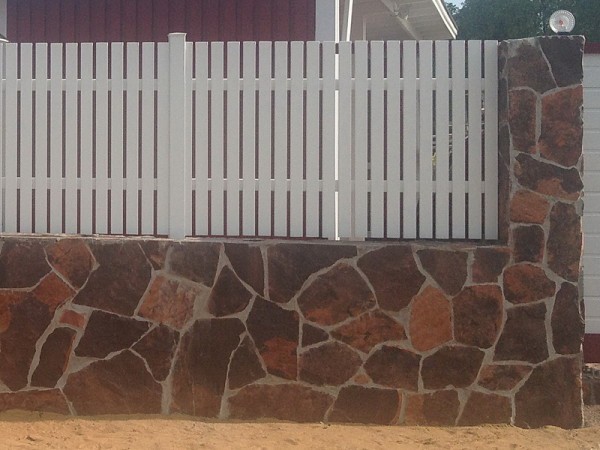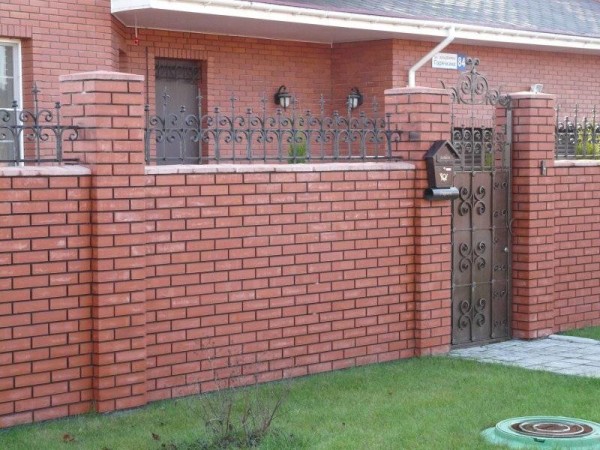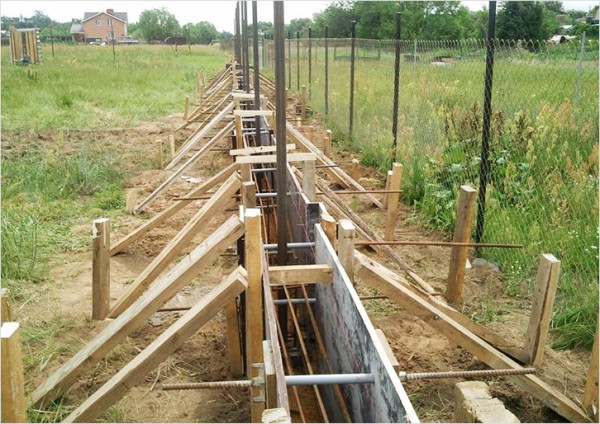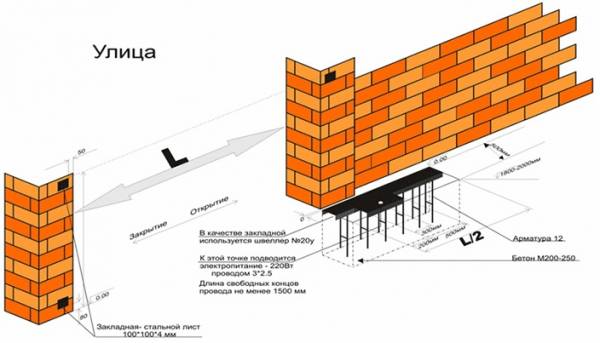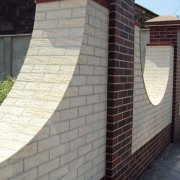Facing a stone fence: types of material and methods of finishing
The fence around the house is quite important and for the most part a very important element. It is especially necessary to protect the territory from intrusions.
In addition, the fence allows you to clearly mark the boundary of the site and, of course, arrange it in a particular style. That is why for construction you need to choose a material that can meet all these requirements.
Therefore, facing the fences with stone becomes the most suitable, because in this case they turn out reliable and beautiful at the same time.
The content of the article
Facing stone fence and its features
Though facing stone for fences is a sufficiently strong material, it is not always chosen for the design of the fence of the site. The fact is that most often such fences seem to owners of houses rather gloomy, gloomy.
But this opinion is erroneous, since at present an artificial stone for facing the fence can be represented by completely different types.
So, you can choose for your site such stones (or their imitation), such as:
- Granite,
- Marble,
- Limestone,
- Shell rock and more.
Depending on what material the frame of the fence is made of, which should be finished with stone, you can choose either natural or artificial material, with which it will be seen that the fence is faced with stone.
For reference. So, if a brick fence has already been put in your dacha, for example, having lost its attractive appearance, then it will be able to withstand natural stone. If the frame is made of metal, then it is better to resort to the use of all kinds of imitations.
Brick fence: stone cladding, instructions and requirements
In the process of facing with stones, difficulties usually do not arise. The main thing is to carry out everything correctly and follow the recommendations of a specialist.
So, for example, when attaching natural stone, you will need to take into account the following requirements:
- The thickness of the stone should be no more than 3 mm.
- Stones should be clean, without any splashes and impurities.
- The surface to be treated must also be cleaned.
- If the lining is performed no higher than 150 cm, then only fixing to the glue is enough.
- If the lining with the stone of the fence is higher than 150 cm, then additional hooking will be required.
- If the height is less, and you use stones with a thickness of more than 3 cm, then mounting on hooks remains mandatory.
So:
- Initially, you will need to pick up stones. Can be made lining the fence artificial stoneas well as natural material.
- The most popular is the use of ordinary natural stone, which, at times, is available in every yard, facing the fence with natural stone is more expensive and requires more time.
- Therefore, if you observe a similar phenomenon in your area (or somewhere near your home), then half the battle has already been done. Having collected the required amount of material, you should proceed to design a fence.
Note. To do this, you need to disassemble the existing stones and (you can directly on the ground or in the utility room) lay them the way you like.
Here everything is subordinated to your imagination and your taste:
- You can simply make a slide in which large stones will be laid at the bottom, and small stones at the top.
- You can soriginalize and put the stones in the opposite order.
- Sometimes there is an erratic arrangement of stones, which is more reminiscent of a natural stone fence.
- Often design depends on the color scheme of stones. So, you can make it colorful or monochrome. To do this, you will have to divide the stones in shades into several groups, and then arrange them the way you like.
Stones can be:
- Sawed off.
- Upholstered.
- Chipped, and even crumbled in some places.
Sometimes, in order to properly position the facing stone for the fence with your own hands, it is recommended to use photos or video instructions. They will certainly help even those who have never before encountered in their life these events.
Preparation of the frame of the fence and facing the pillars with stone
So, having prepared all the finishing materials for fence cladding, you will need to stock up on both tools and additional materials.
In order to make fences from facing stone, you will need:
- Hammer,
- Chisel or chisel,
- Tile adhesive for outdoor use,
- Construction mixer,
- Electric drill,
- Putty knife,
- Reinforcing mesh
- Wire,
- Wood screws
- Dowel,
- Washers
- Cement mortar
- Grout
- Water repellent solution.
Stages of work:
- As already mentioned, the surface of both the stones and the fence must be cleaned. Therefore, it will be necessary to remove all contaminants with a brush, mop, scraper or broom and only after that proceed with the installation of facing stones.
- The finish, as well as the lining of the pillars for the fence of stone, should be attached to the reinforcement. To do this, you need to purchase a special mesh with 5x5 cm cells.
Or you can do it yourself with a wire grid. - The thickness of the mesh and wire should be at least 15 mm. Fasten them to the fence with dowels, screws and washers.
- The next stage of installation is plastering the mesh. This is necessary so that nothing could penetrate under the stone for facing the fence posts.
This applies to moisture, debris and some harmful insects and other parasites. For plastering, you need to prepare a cement mortar.
For reference.
Its composition includes 1 part of cement, 3 parts of sand, 1 part of water. All this needs to be mixed up gradually.
First, cement dissolves in the water, then sand is added. You can add a plasticizer (about 75 grams) in order to remove excess moisture from the solution.
In this case, your frost will not be afraid of any frosts.
- A plasticizer is added immediately after the cement has dissolved in water. In this case, you may need even less water, as the plasticizer will do a great job of diluting the solution.
- In order for the stones to attach well to the plastered wall, it is recommended to add coarse-grained filler to the cement mortar.
With its help, the fence wall will become rough, respectively, and the glue to it will stick much stronger and better. After this, it is necessary to leave the fence for about 1 day in order for the plaster to dry.
Once you are sure that the cement mortar has already hardened, you can go to the finish line - fixing the stones, for this you will need:
- Tile adhesive for external use,
- Cement,
- Sand.
Work:
- All this is mixed in a ratio of 1: 1: 2. Add water by eye, depending on the quality of the sand.
Kneading the solution gradually, bring it to the consistency of very thick sour cream. The solution should very slowly slide off the spatula, but not fall or drain from it.
For reference. If the stones are too large, and the fence is supposed to be made high enough, then you should first drive the pins into the fence, and drill holes in the stones.
Then the stones will simply be planted on these hooks. This method allows you to perform the cladding as efficiently as possible.
- The finished solution should not be applied to the fence, but to stones that are alternately pressed against the surface to be treated.
- Stacking of stones begins from the bottom. If necessary, the stones can be sawn off or broken so that they fit on the fence.
- At the same time, carefully monitor the gaps between the stones. They should not be pressed close to each other. The optimal distance between adjacent stones is 1.5 cm.
- After this, it is only necessary to wipe the gaps between them. For this, a special grout can be used (while its color can be selected in accordance with the shades of the stones) or, if you still have glue, you can also use it.
- In conclusion, it remains only to wash the stones from the cement-adhesive mortar and cover the finished fence with a water-repellent solution, which will protect it from moisture.
If the artificial stone is lined with a fence, then everything is somewhat simpler, because for the most part imitations are much less weight and therefore can be used on absolutely any surface. Here you don’t even need to mix sand and cement with ordinary tile glue.
Accordingly, the price of the fence lined with artificial stone will be significantly lower than that which was decorated with natural material.
